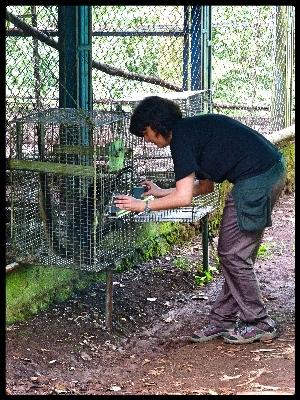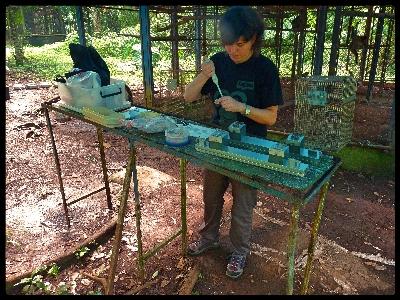Material and Methods
The animals
The study was carried on at the Field Station Pipiapan in Catemaco, Mexico.
Five spider monkeys, four females and one male, aged between 8 and 15 years old, were used for this study.
The animals were housed in single enclosures, which had a smaller test cage attached of 80x50x50cm, that they would access after a command, voluntarily, and always being free to leave.

The odorants
Two neo-tropical fruits consumed by spider monkeys were selected:
Leonia cymosa and Couma macrocarpa
The partners on the German Primate Center obtained the chemical composition of the odours of this fruits, both for the conditions of ripe and unripe, but also for the conditions of intact and open fruit.
Whereas C.macrocarpa presented very different odour profiles for both intact and open conditions both in ripe and unripe fruits, L.cymosa presented similar odour profiles for the condition of open fruit for the ripe and unripe fruits.
Therefore, it was decided to test the following conditions:
- C.macrocarpa intact
- L.cymosa intact
- L.cymosa open
The odour mixtures were prepared using diethyl phtalate as solvent.

Method
An apparatus for food-rewarded conditioning paradigm was used, in which the animals were simultaneously presented with two options, one correct and one incorrect. When the monkeys chose the correct option, they were immediately food-rewarded. If the incorrect option was chosen, the reward was withheld.
(S-) Unrewarded --> Corresponding to the unripe (or modified unripe) odorant
(S+) Rewarded --> Corresponding to the ripe odorant
The box that held the paper strip impregnated with the odorant considered as the rewarded stimulus (S+) was baited with a food reward consisting of a Kellogg’s Fruit Loop cereal, while the box holding the strip impregnated with the odorant considered as the unrewarded stimulus (S-) was empty.
Experimental plan
1. Learning of the rewarded stimulus (S+)
Ripe (S+) vs anethole 1:500 or water
2. Ability to discriminate between ripe and unripe fruit odours
Ripe (S+) vs Unripe (S-)
3. Ability to discriminate between ripe and partially ripe fruit odours
Ripe (S+) vs modified Unripe (S-), with one or more compounds at ripe concentration.
Responsible for this page:
Director of undergraduate studies Biology
Last updated:
05/28/15
